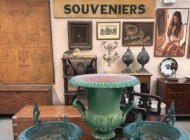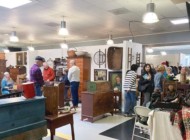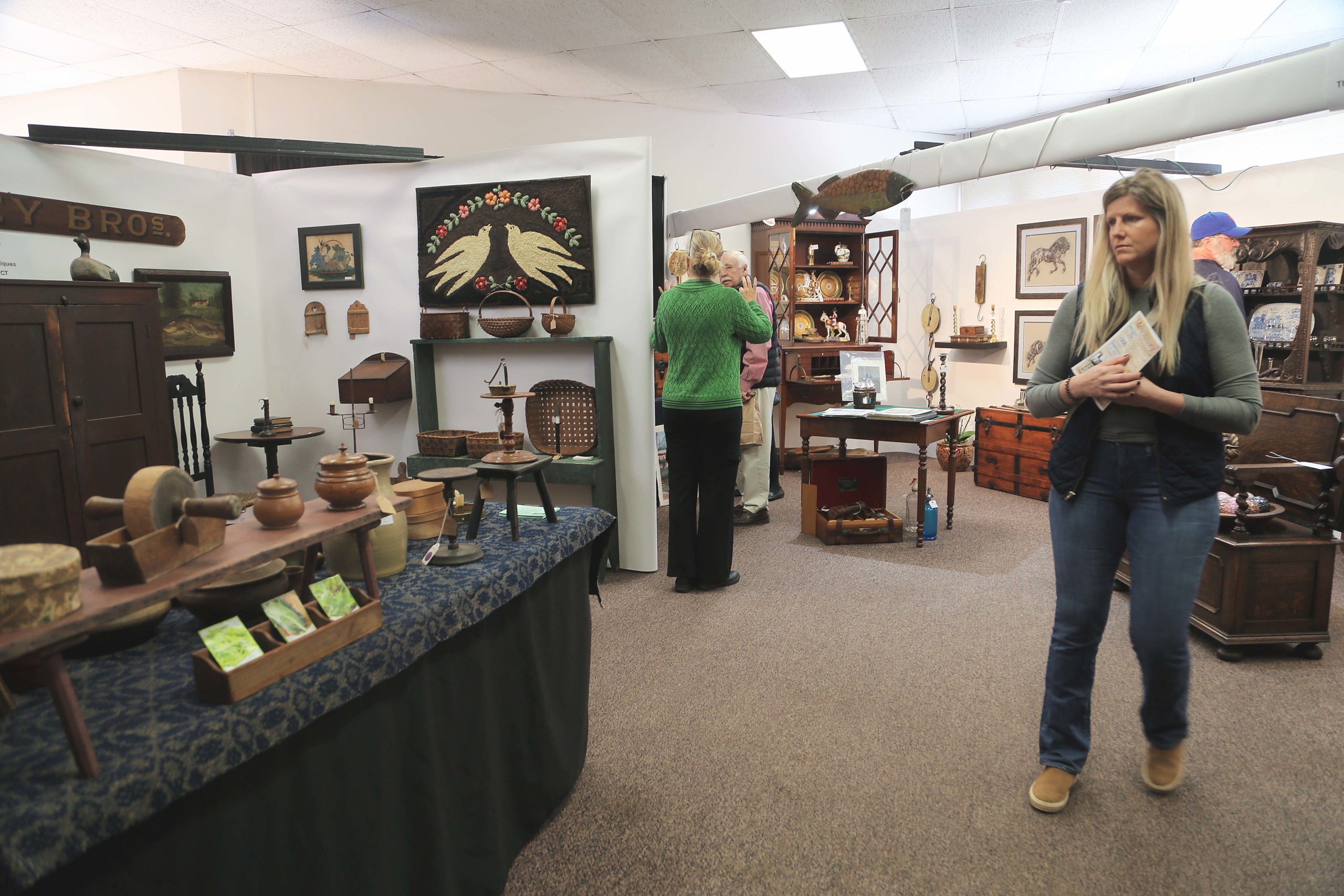
Sasha’s Antiques, Orange, Conn., on the left, was set up alongside Three Graces Antiques, from St Petersburg, Fla.
Review & Onsite Photos by Madelia Hickman Ring
HIGGANUM, CONN. — The Connecticut Spring Antiques Show, which was founded in 1973 and which, for four decades until the pandemic, took place in Hartford, Conn., benefitted the Haddam Historical Society (HHS). Seeking to revitalize what this publication once dubbed “one of the most important antiques shows in the nation,” the HHS partnered with John and Elizabeth DeSimone and Goosefare Antiques and Promotions to resurrect the event, which came together at the now closed Haddam Elementary School in Historic Higganum on Saturday and Sunday, October 19-20. A few differences were immediately obvious to those who once patronized the Hartford event: a slightly smaller cadre of dealers set up in 10 separate small rooms throughout the old school rather than in one large space. And, in an effort to attract new attendees, the show promoters added content geared towards historic homeowners: two public programming events — a lecture and a roundtable discussion — by historic home restorers and a selection of craftspeople working in historic traditions.
Despite gloriously sunny weather and annual fall events like pumpkin picking and leaf-peeping that compete for attendees’ attention, the show attracted a large and steady crowd throughout the weekend, with about 700 by the time the show closed on Sunday afternoon.
Elizabeth Malloy, executive director of the HHS, spoke with Antiques and The Arts Weekly a few days after the show.
“The show exceeded our expectations and I think we did really well. It was a beautiful weekend and there were lots of other things going on, but we got a lot of local people to come, as well as many people who used to come to the show when it was in Hartford. We are very, very pleased.”
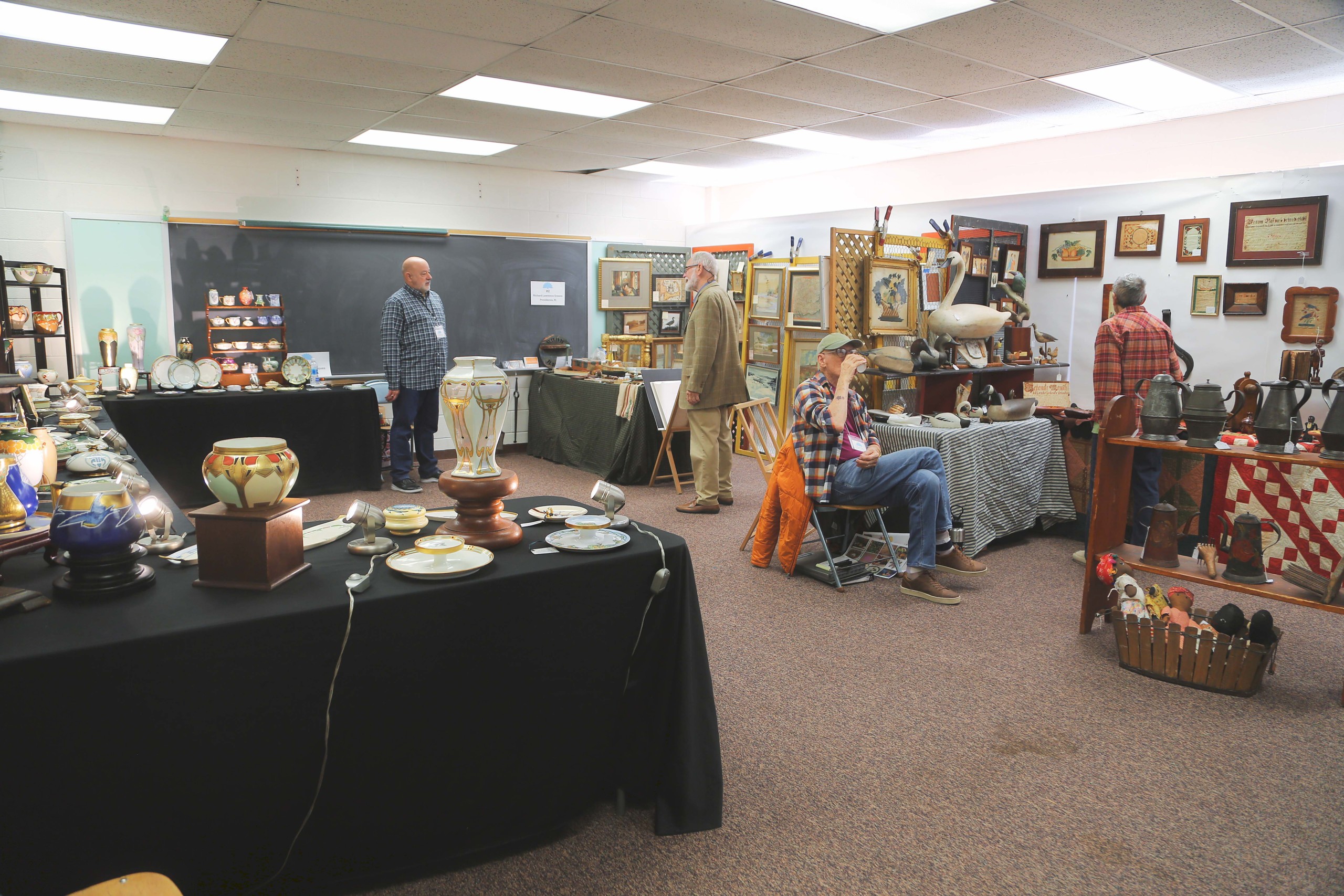
The first room past the entrance housed three dealers, shown here, from left: David Weidner with Dark Flowers Antiques (Haverhill, Mass.); Richard Lawrence Greene (Providence, R.I.); and Marvin Weis Folk Art & Antiques (Baltimore, Md.).
She was candid about the spread-out floor plan necessitated by the show’s venue. “We wanted to keep it local and looked relentlessly for a venue that would fit all the dealers in one space: universities, colleges, hockey rinks, tennis courts; I have a list of almost 100 places we considered. The school wasn’t bad and cleaned up nicely. It was much more intimate than the armory and, since there was a worry that some visitors might not see all the rooms people were exhibiting in, we had ‘hall monitors’ to help direct people.”
Dealers and visitors who did not like the layout may be reassured to hear that the school will be converted to affordable senior housing and future shows will not take place there.
The partnership between the HHS and Goosefare was on the recommendation of Tim Jarrell, a former HHS board member and the co-chair of the show. “We knew Goosefare did the Tolland Antiques Show and are one of the few promoters of antiques shows in the Northeast. They also had connections with many of the dealers from the Hartford show, so it was a logical connection,” he said, further elaborating on the show’s layout, “By having different rooms, it allowed people to linger more rather than just going down an aisle of dealers.”
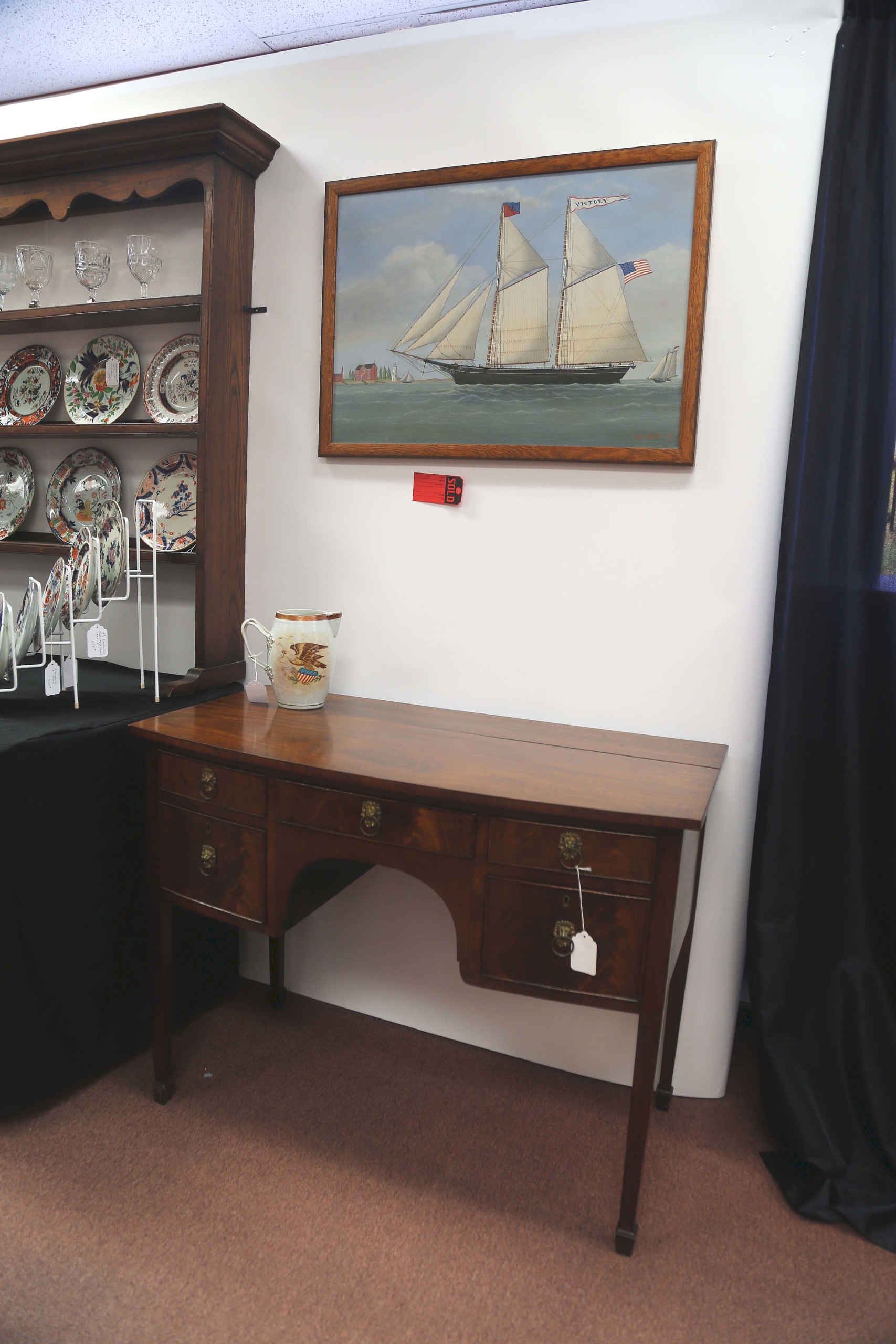
One of several sales transacted by John and Elizabeth DeSimone, Goosefare Antiques, who are also the promoters of the show. Saco, Maine.
John DeSimone, who also thought the show looked great, was particularly pleased with the attendance, noting the turnout was “very busy on Sunday, which was a bit of a surprise.”
One immediately apparent constant between the original show and this one was the high caliber of objects on offer and the dealers, including eight that had been longtime participants in the Connecticut Spring Antiques Show.
Marvin Wies, Richard Lawrence Greene and David Weidner shared the first space past the entrance. Wies noted traffic on the first day had been “good for a first time show.” On offer in the room were brightly colored brides’ boxes and Stiegel bottles with Wies, framed artwork and smalls with Greene and Weidner’s painted porcelain.
Willow Springs Perennial Antiques’ Nancy Douglass and Palisades Trading Company’s Tom Landers shared the adjoining space. Landers gave us a lesson in dating rugs, specifically that the presence of purple identified the rug as having been made in the late Nineteenth Century. He used a Kazak carpet to demonstrate this.
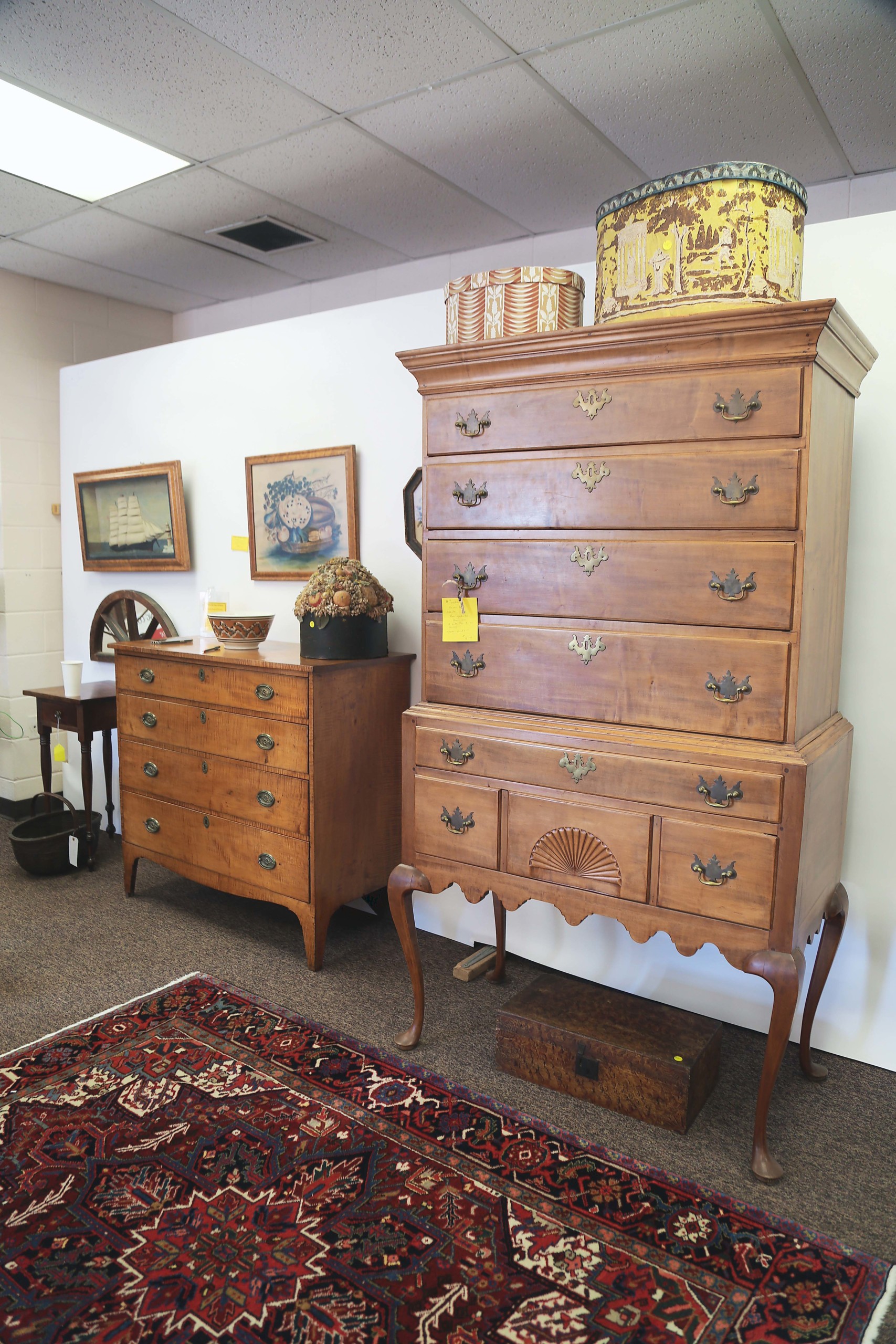
Willow Springs Perennial Antiques, Rexford, N.Y.
A ship painting was among Douglass’ sales on Saturday. Notable standouts in her booth included an Eighteenth Century Queen Anne flat top maple high chest and a Federal tiger maple four-drawer chest with a one-board top.
Continuing down the hallway, one found the booths of Captain’s Quarters, Amherst, Mass., and Witt’s End Antiques, Walkill, N.Y. Captain’s Quarters’ Jeffrey, Ann and Chris Cobb hung the exterior of their side wall with nine linsey woolsey international signal flags from the US Nemo that dated to the Nineteenth Century and came with their original canvas holder. Setting off the flags were two crayon and pen on paper pictures, one titled “Battle at Sea — War of 1812,” the other “Battle at Sea — American Revolution.” Made by the same unidentified American folk artist, they were being offered separately.
Karen and Chris Doscher are Witt’s End Antiques; a bench-made Windsor armchair they were offering was marked “sold” on Saturday. Other pieces that generated interest from showgoers were a wall-mounted apothecary box with lift top and doors, made in the early Twentieth Century in the Hudson Valley, and a blue-painted wall box from the same area.
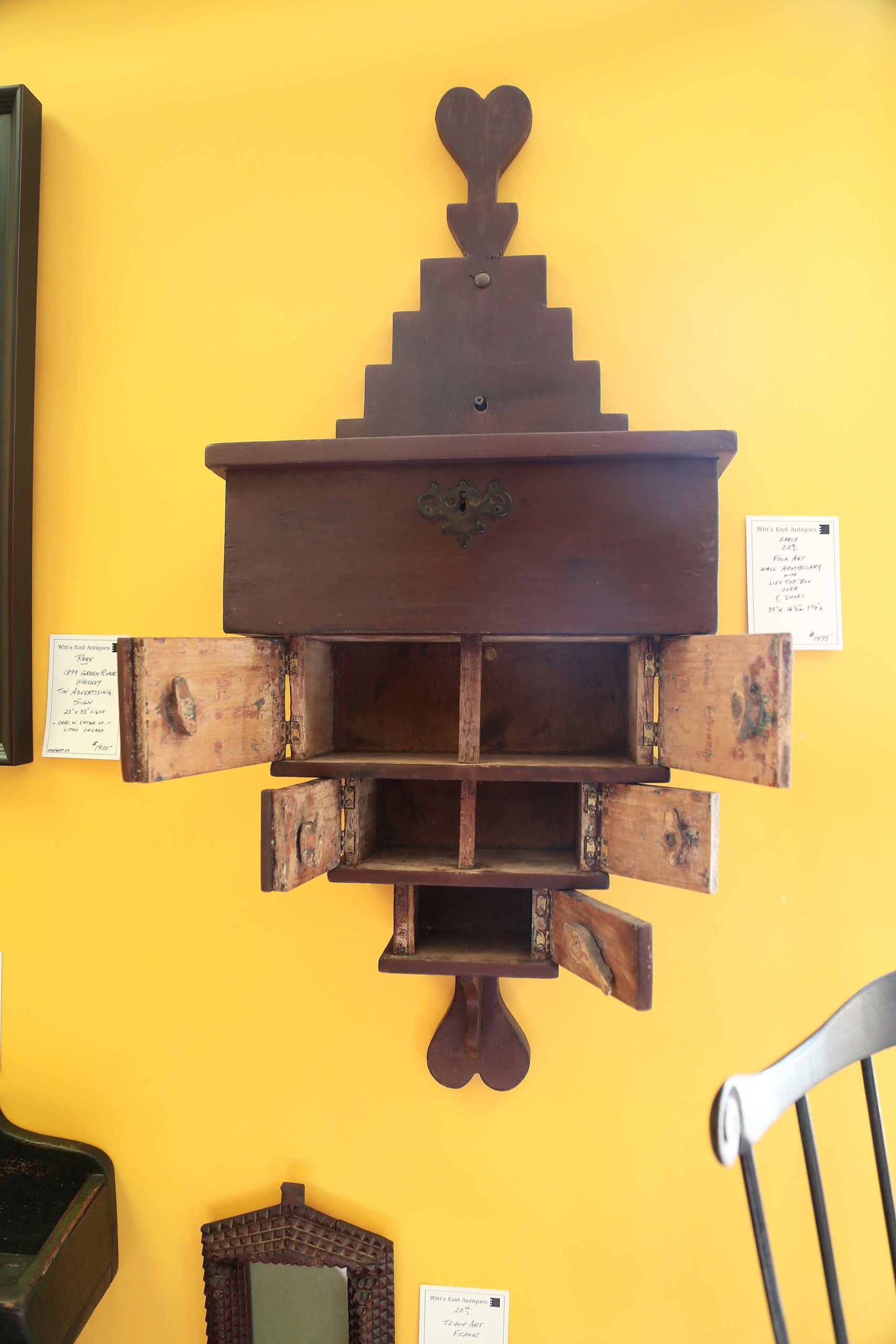
Witt’s End Antiques offered this striking wall mounted apothecary box with heart-shaped top, that was probably made in the Hudson Valley in the early Twentieth Century. Wallkill, N.Y.
In the room across the hall, Cathy Cwilichoski, Tucker Frey and Donald Broderick and Tony and Laura de Haas were spread out. Frey said shoppers on Saturday were “informed and knew what they were looking at.” He said he’d made several sales on the first day, including three Windsor chairs, a gun, a fire bucket, an Eighteenth Century telescope, a ship painting, a photo postcard of a cigar store figure and some smalls.
“We’ve had a lot of people through, with more looking than buying,” shared Tony de Haas, who nevertheless closed deals on a Pennsylvania chair, a crystal regulator with mercury pendulum and a cast iron doorstop in the form of a ship.
It was time to turn the corner and venture down the hallway to a long room that housed six dealers, including the booths of show veteran Randi Ona and promoters John and Liz DeSimone.
The show was Ona’s last one for the season and she had brought several great things, including three wonderful folk portraits. Her largest, a pastel done around 1830, depicted a woman in white wearing wonderful jewelry, above two smaller portraits, one by Jane Davis, the other by Jasper Miles that she described as being “in perfect condition.”
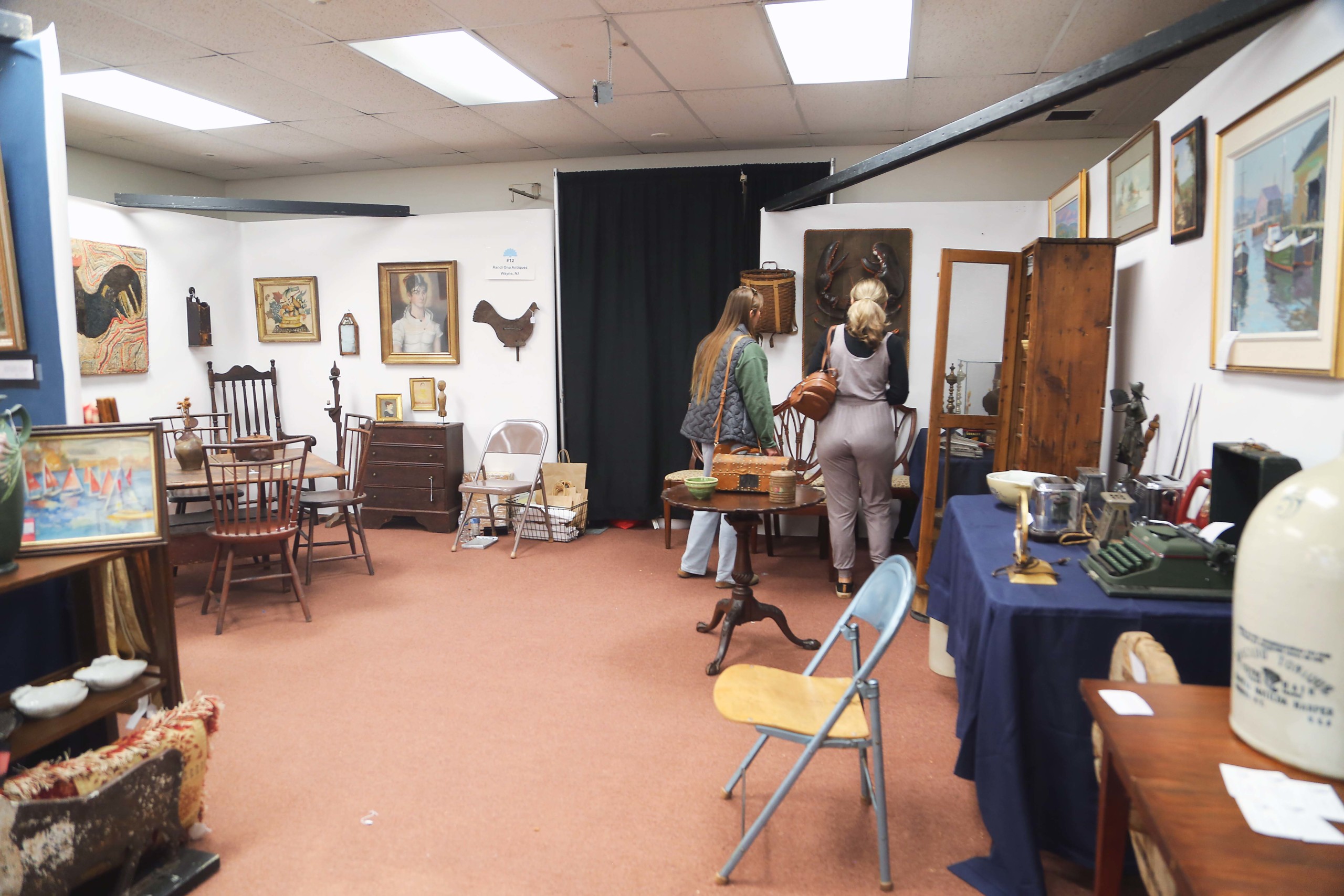
In this photo’s far left-hand corner, longtime Wayne, N.J., dealer Randi Ona was set up next to Luke Villani and Timeless Treats and Relics, a last-minute entry from Vernon, Conn.
Bruce Henley, New England Homes Antiques, reported first day sales of a table, a hooked rug and bottles. Visitors were also attracted to two watercolors by William Paskell he was offering together.
Deirdre Healey had a good selection of antique and vintage jewelry but what she was most interested in showing us were two shoe-form pieces, one to display rings, the other a pin-cushion. She sold five pieces on the first day.
“It’s a pretty decent show; you can sell here,” said John DeSimone, noting he’d sold “a little bit of everything.” That would have included a Pennsylvania tall chest of drawers that he delivered to its new Rocky Hill, Conn., home after the show closed on Saturday. A ship painting also sported a red sold tag.
Luke Villani, proprietor of Timeless Treats and Relics, also works for the auction house Winter Associates in Plainville, Conn. When another dealer backed out of the show at the last minute, he stepped up and had several interesting things, including taxidermies of a lobster and a mallard duck.
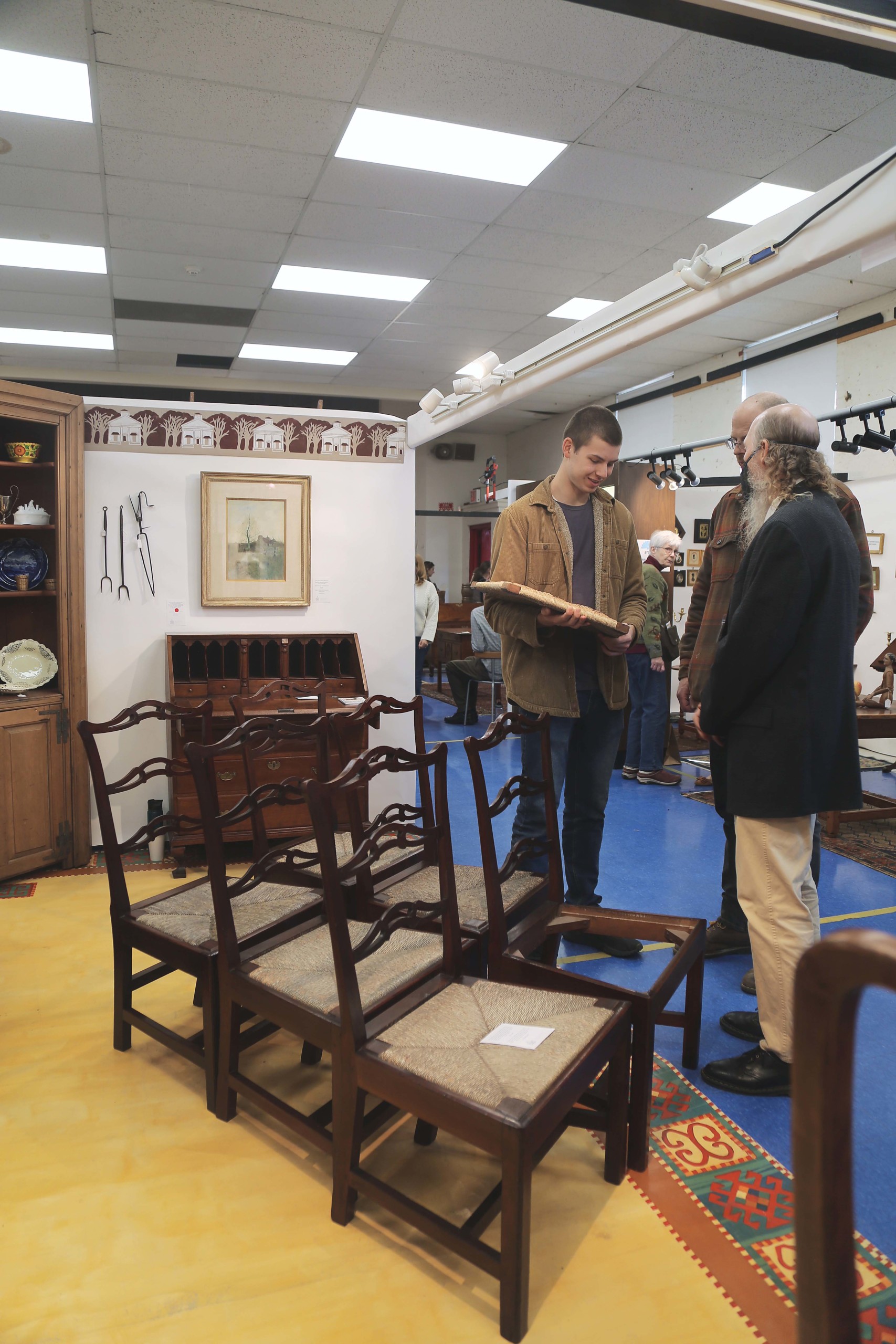
Kevin Tulimieri, in the dark coat to the far right, had a ready audience for any pearls of wisdom he could impart on the finer points of chair making. The slant lid desk on the far wall — made in Norwich, Conn., circa 1745, was sold during the show. Nathan Liverant and Son, Colchester, Conn.
Moseying down another hallway, we reached the largest room where the greatest concentration of dealers were assembled, eight in all, six of which had signed up for the show hoping to experience the same magic of the earlier Hartford show.
One of these was Arthur Liverant, of Colchester, Conn., -based Nathan Liverant and Son. Both Liverant and his long-time colleague, Kevin Tulimieri, have a passion for educating potential or existing clients and both found steady audiences for mini talks within their booth. While we were in the booth, Tulimieri was engaged with a father and son in a discussion about the process for making rush seats on period chairs. The example that he used to show the finer points was a matched set of six Chippendale cherry side chairs, made in the Connecticut River Valley between 1790 and 1815.
Colette Donovan, Merrimacport, Mass., and Joy Hanes, Hanes & Ruskin, Niantic, Conn., were opposite Liverant and both brought a large selection of quality Americana, smalls and framed works.
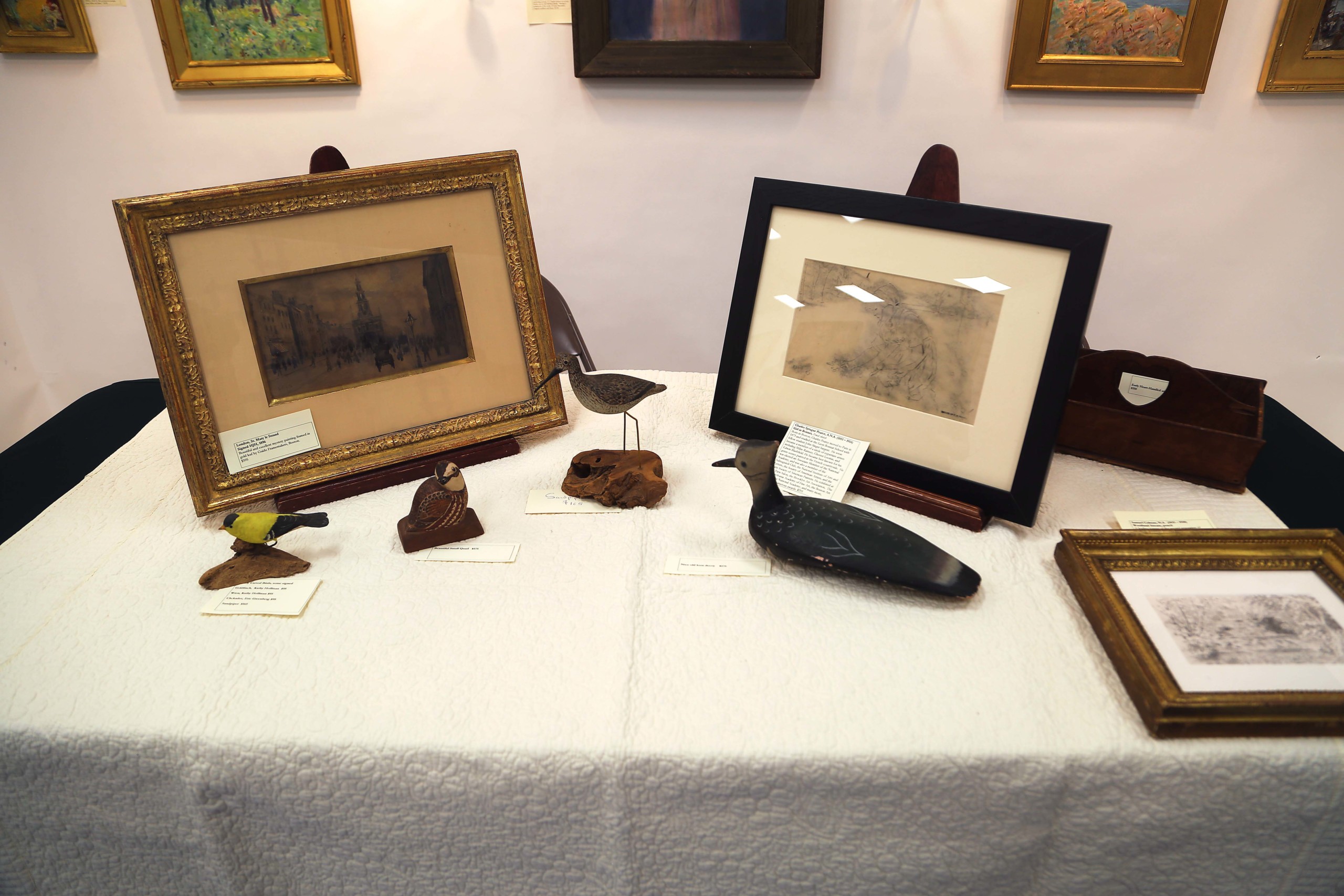
David & Donna Kmetz, Douglas, Mass.
Fine arts dealers Kevin Rita and Donna Kmetz were in adjoining booths around the corner and both noted sales. We were in the booth of Garvey Rita Art & Antiques, Orleans, Mass., when Rita closed the deal on a pastel on paper work titled “Exuberance” by Wolf Kahn (1927-2020). It was one of two similar works he had, as well Frank Du Mond’s (1865-1951) important “The Pond in Spring,” which Rita had recently acquired from Jeff Cooley.
Kmetz pointed out a few works by Francis Draper (1861-1935) that had provenance to the artist’s estate. Her booth was centered by a table upon which were placed four modern carved bird decoys, a small painting of London, St Mary le Strand, signed “HJH” and dated “1896,” as well as a pencil sketch of a girl in a bonnet, by Charles Sprague Pearce (1851-1914).
A long hallway leading away from the auditorium housed even more dealers. Paul and Kethy Steinberg, who live comparatively close to the show in Orange, Conn., were in the same room as Kelly McGee and Blair Govel, a mother-daughter team, who traveled to the show all the way from St Petersburg, Fla. “We had lots of foot traffic and lots of interest,” McGee reported. A carriage seat, smalls and a late Nineteenth Century French walnut table perfect for an entryway were among their sales.
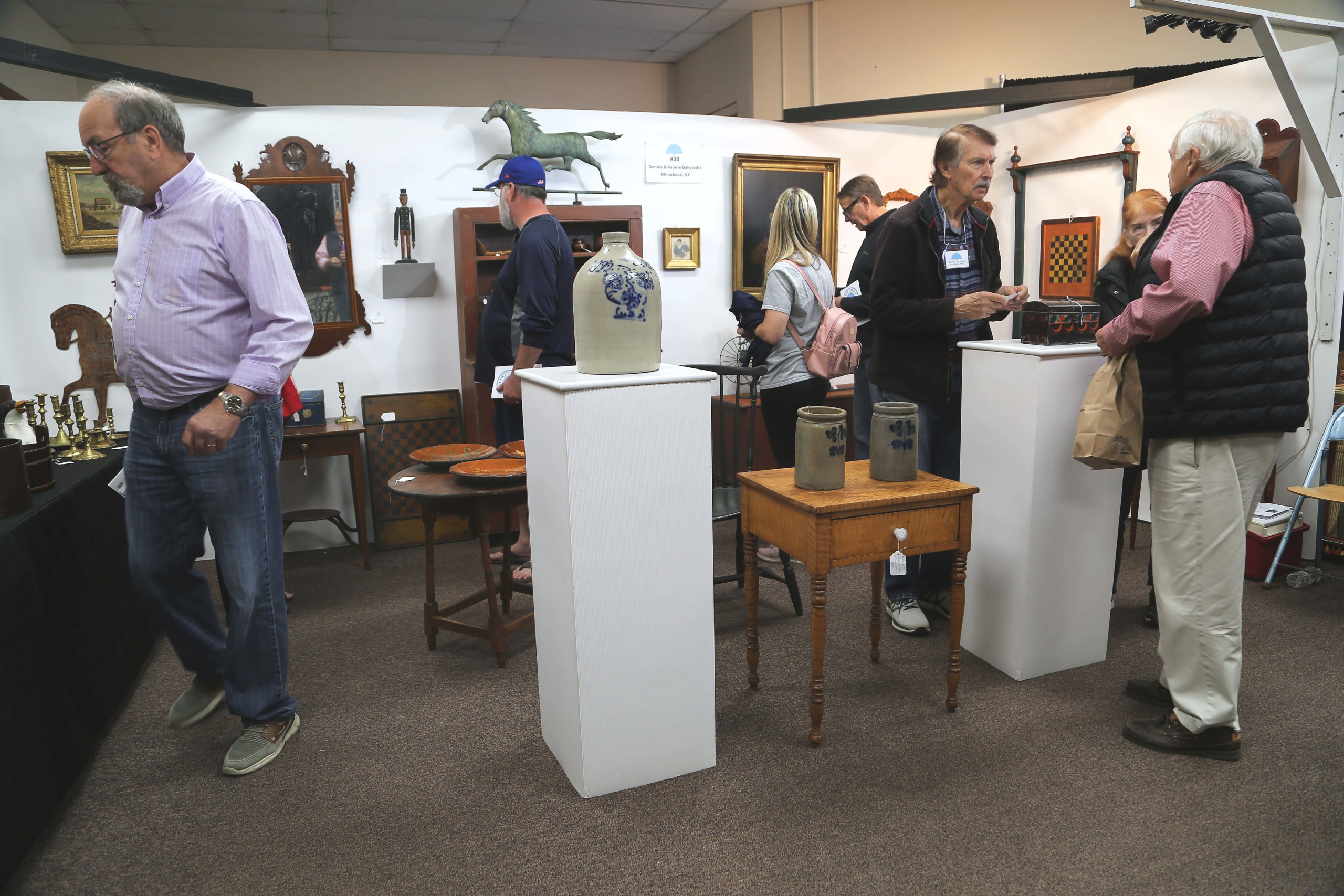
Dennis & Valerie Bakoledis, Rhinebeck, N.Y.
Four more dealers were set up two additional rooms. Dennis and Valerie Bakoledis shared space with Greg Hamilton; all were busy chatting with old and new clients as we passed through The Bakoledis’ showed a nice pair of carved wood frames, a Nineteenth Century tobacco cutter, a circa 1828 American school portrait of an officer, a circa 1930 copper sulky weathervane and a New England blanket chest with bootjack ends that dated to circa 1820.
Hamilton, who is Stone Block Antiques in Vergennes, Vt., had a broad variety that included a painting of draft horses, Native American beadwork, a lighthouse-form lamp, a Federal chest of drawers, a pair of small Chinese pottery camels and a larger Chinese pottery horse. A glass case at the front corner of Hamilton’s booth supported an impressive circa 1980s gilt sterling epergne made by the Italian silversmith, Antonio Bragante.
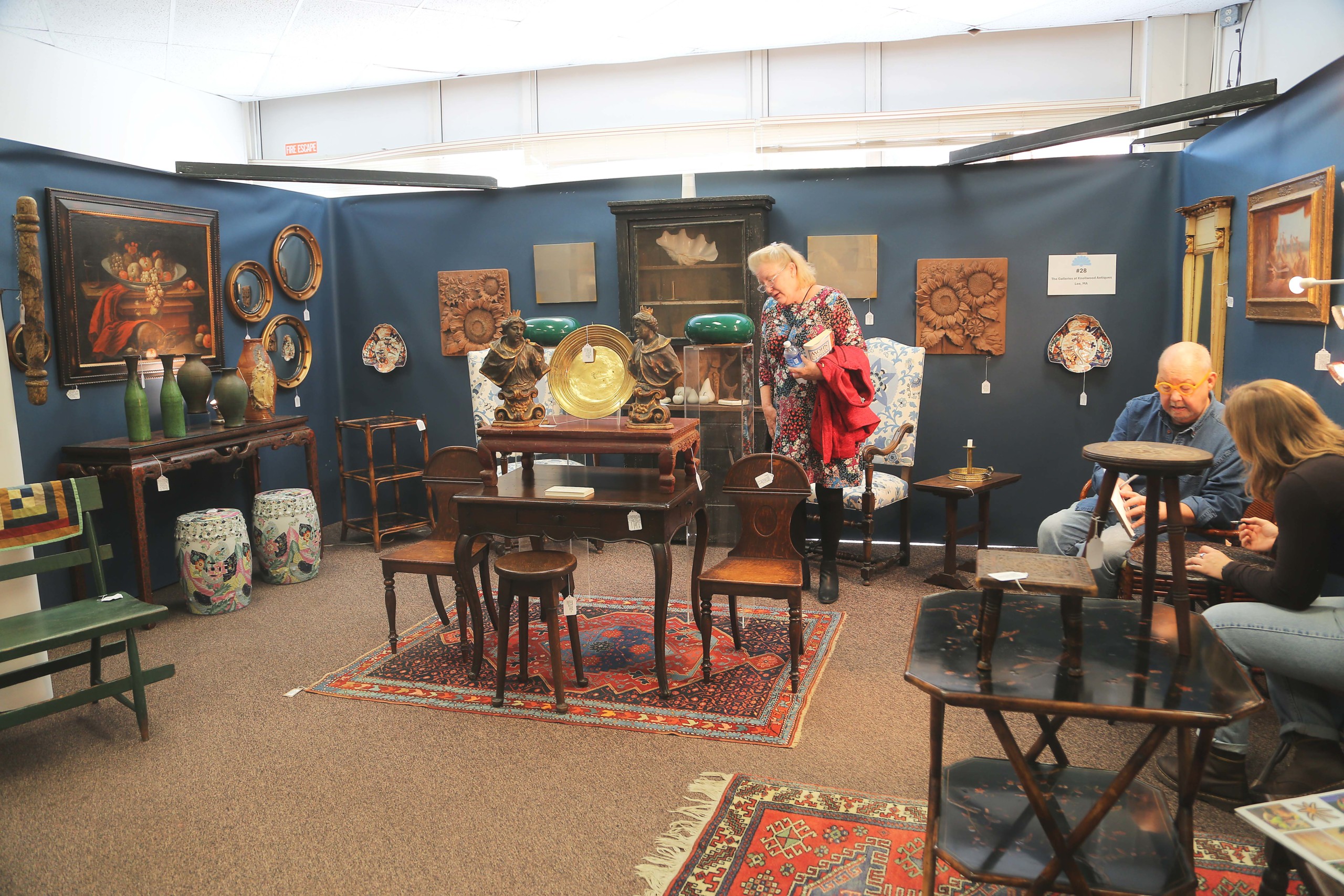
Richard A. LaVigné, seated on the right, wrote up the Aesthetic Movement bench he’s sitting on. An important Flemish still life hangs on the wall, far left. The Galleries at Knollwood Antiques, Lee, Mass.
Across the hall, Jim Luskey and Richard A. LaVigné were comfortably ensconced. Luskey had a varied and eclectic mix of goods, including painted furniture, advertising and gameboards. LaVigné, the mastermind behind the recently opened Galleries at Knollwood Antiques, presented an upscale aesthetic, with high-style furniture and decorative arts. As we were in his booth, he sold an Aesthetic Movement bench to a client in Florida. He pointed out a striking Eighteenth Century Flemish still life that had just arrived from Europe.
One room was dedicated to people who provide services of varying kinds to owners of historic houses. Have an old door that needs a working lock? Derek Collins, a professional blacksmith based in Haddam, can help with that, telling us, “I just want to make things for people.” Want to have a sign reproduced for your old home? Tim Kearns (www.handpaintedwoodsigns.com) had a display of ones he’s made and other options to choose from. Stanley Peck is Old Lights On, in Farmington, Conn.; he buys and sells restored lighting and brought a selection of different examples. Rebecca Lineberry of 1755 Design Co., who gave a roundtable discussion on Sunday afternoon, was on hand to talk about her experiences restoring antique homes. Stacy Jameson, The Seeded Garden in Higganum, had pamphlets supporting her mission to help bring organic gardens back to Connecticut yards.
Dates and a venue for a 2025 show have not yet been finalized. For information, www.goosefareantiques.com or www.haddamhistory.org.
































